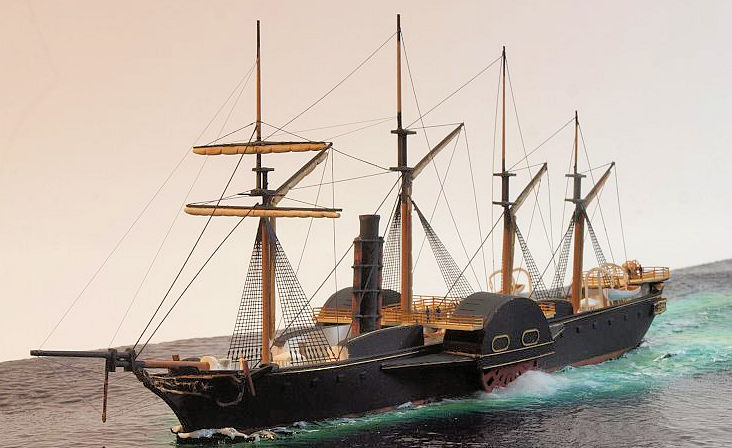
| KIT #: | 01261-6 |
| PRICE: | 10 euros on the used kit market |
| DECALS: | paper flags |
| REVIEWER: | Frank Spahr |
| NOTES: | 1976 release |

| HISTORY |
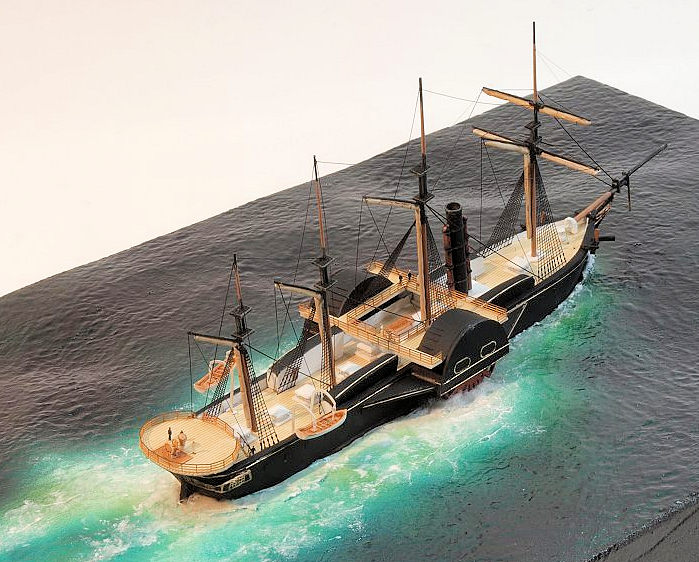 The Great
Western was the first steamer purpose-built to cross the Atlantic. It was the
first of three vessels designed by I.K. Brunel, a true engineering legend of the
Victorian era. Each of the three vessels would set new standards and push the
envelope, with the last one quite boldly overstretching it indeed.
The Great
Western was the first steamer purpose-built to cross the Atlantic. It was the
first of three vessels designed by I.K. Brunel, a true engineering legend of the
Victorian era. Each of the three vessels would set new standards and push the
envelope, with the last one quite boldly overstretching it indeed.
Great Western was built traditionally from oak and had side paddle wheels. Her two-cylinder Maudslay engine of 750 hp gave her a top speed of 8.6 knots. A four-masted sailing rig augmented the steam engine. The vessel was laid down in 1836 and had her maiden voyage in April, 1838.
She successfully operated in trans-atlantic service until 1846, when her parent company went bankrupt. After several years of service to the West Indies and a stranding, she was used as a troop transport in the Crimean War, to be broken up in 1856.
This was an era of rapid progress; the next vessel designed by Brunel, SS Great Britain, was much larger then Great Western, had an iron hull, and screw propulsion. Great Western still has the distinction of being the ship that started transatlantic passenger service under power.
| THE KIT |
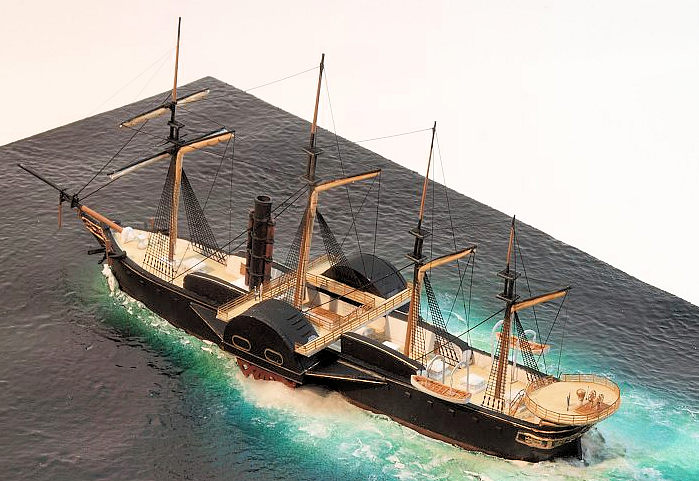 I happened
upon this kit in its 1976 boxing at a vintage kit booth at the 2018 Scale Model
Challenge at Veldhoven, the Netherlands. They had oodles of ye aulde Airfix
kittes, but this one took my fancy. I had the feeling I would have fun building
it, and that is what counts for me these days.
I happened
upon this kit in its 1976 boxing at a vintage kit booth at the 2018 Scale Model
Challenge at Veldhoven, the Netherlands. They had oodles of ye aulde Airfix
kittes, but this one took my fancy. I had the feeling I would have fun building
it, and that is what counts for me these days.
Laters I found out that the kit was first produced in 1957. It had been in the company´s program on and off, and also been marketed by Heller under the name Atlantic Star. It has been out of production for a long while now.
Given the kit´s origin, it is rather basic, and much of it looks rather clunky. Comparing it to images of the very nice model of Great Western formerly on display at the Science Museum in London, I found the small model held up quite nicely, though. I can but recommend a visit to S.S. Great Britain in Bristol, a most impressive and enjoyable museum. Looking through the images I took there and into the guidebook I bought also helped me to get a feeling for how the vessel had looked like.
| CONSTRUCTION |
Building started with deciding on how to display the model, and how to modify the kit. I wanted to show the vessel underway on a seascape, giving me ample opportunity of playing around with water disturbed not only by the hull, but also by the two paddle wheels.
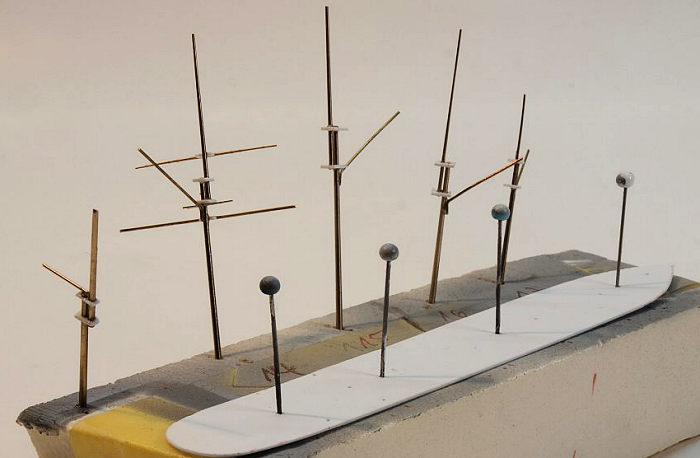 Looking
through the kit parts, I decided that most of them would need replacing. In the
end, I retained the hull halves, the paddle wheels and their fairings, the
funnel, the tops of the skylights and the anchors. The deck „planking“ was very
crude, so main deck, flying bridge and steering platform were replaced with
Evergreen v-groove stock.
Looking
through the kit parts, I decided that most of them would need replacing. In the
end, I retained the hull halves, the paddle wheels and their fairings, the
funnel, the tops of the skylights and the anchors. The deck „planking“ was very
crude, so main deck, flying bridge and steering platform were replaced with
Evergreen v-groove stock.
The masts and yardarms were equally crude, so they were replaced with tapered brass stock and styrene parts. Most of the superstructure was rebuilt from styrene stock, only the roofs of the skylights were removed from the kit and reused. On the hull, the quite notable „gold trim“ was simulated by gluing .2 mm brass wire in its stead. For the oval trim on the paddle wheel boxes, I found some parts in L´Arsénal´s often helpful Structural Parts. After priming and painting, the brass was carefully exposed by paring away the paint from it. The quite prominent windows on the vessel´s stern were simulated by pieces of PE grating cut to size.
As usual, I started the base quite early on. In hindsight, I had chosen a too small display box, so the minimal seascape would look very cramped. Hence I replaced the base with a larger one, on which the vessel was placed asymmetrically to show her wake and the disturbed water in it.
The paddle wheels were also rather crude and didn´t
fit too well. I reckoned that only a limited part of them with about three
paddle blades would be visible at all between the box and th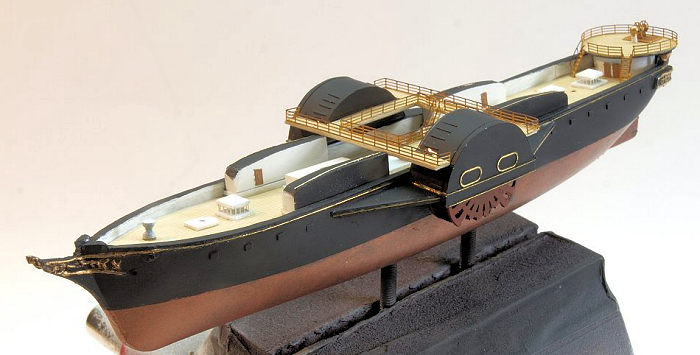 e
water, so I trimmed the lower part of both wheels and substituted the visible
blades with replacements from stock styrene.
e
water, so I trimmed the lower part of both wheels and substituted the visible
blades with replacements from stock styrene.
The base was prepared in my usual method. I started with an oversize piece of insulating board. Upon determining the position of the vessel, I made a cutout for the hull, to make it fit as snug as possible. As I never get that quite right, I mask the hull with tape and then fill any remaining gaps with acrylic caulking. But only after I have shaped my wave pattern with a gas burner (very carefully, and under proper ventilation!!). The shaping done, I cut the piece to its final size, as that leaves neater edges. Having filled the gaps, let the caulking cure for two days, and having removed the model, I trim any excesses and then stipple white wall paint onto the base, as that leaves a surface texture that quite closely resembles that of the sea. The paint dried, I use a shade of green acrylic paint in my airbrush, applied away from the hull, followed by one or two shades of blue, to bring the desired shade to the seascape. I tend to stop at some point, sleep on it and revisit the day after. Any further wave effects are made from clear gloss acrylic gel, drybrushed where necessary with white artist´s oil paint. Working in two layers adds more depth. So I add some gel after bringing in the colour, do some drybrushing, and then let everything cure well. I mean at least a week, better two. I need to avoid residual moisture from my water-based paints, as it would lead to bubbles in the surface of the gloss clear coat. I use solvent-based clear gloss from a rattlecan from the hardware supermarket. That also needs ample drying time, as it´s sticky much longer than you might believe.
Now, further wave effects may be added using clear gloss acrylic gel, highlighted with white artist´s oil paint.
On the model, I continued with the remaining subassemblies. A double steering wheel was fashioned out of some leftover PE cable reel assembly, the boats were sourced from a sprue of some 1:700 Hasegawa IJN ship kit, the davits I found in my spare PE folder. The anchors are a combination of the kit items with some styrene stock and PE rings.
| COLORS & MARKINGS |
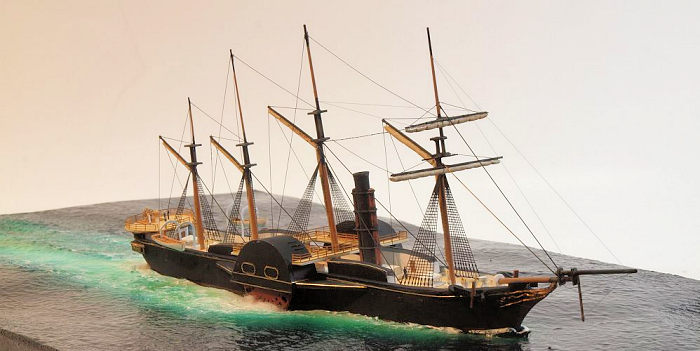 The model
was primed with Stynylrez primer, black for the hull and masts, white for the
rest. The waterline was then masked and the lower hull painted copper using AK
Interactive´s TruMetal. The wooden deck was sprayed a tan shade, the „planking“
enhanced with a brown wash. The paddle wheels were primed in black and then
sprayed red, to achieve a dark/rusty red shade. The masts and yardarms were
painted black and a wooden shade, followed by some drybrushing. The furled sails
were „sculpted“ from Apoxie Sculpt, sprayed a light tan and also received a
light brown wash. Prior to mounting the masts to the ship, the sails were added
to the masts to ease work.
The model
was primed with Stynylrez primer, black for the hull and masts, white for the
rest. The waterline was then masked and the lower hull painted copper using AK
Interactive´s TruMetal. The wooden deck was sprayed a tan shade, the „planking“
enhanced with a brown wash. The paddle wheels were primed in black and then
sprayed red, to achieve a dark/rusty red shade. The masts and yardarms were
painted black and a wooden shade, followed by some drybrushing. The furled sails
were „sculpted“ from Apoxie Sculpt, sprayed a light tan and also received a
light brown wash. Prior to mounting the masts to the ship, the sails were added
to the masts to ease work.
| FINAL CONSTRUCTION |
Given the limited number of parts, that didn´t take overly long. After adding the deck and its limited superstructure, the flying bridge and the steering deck were added. Leftover 1:500 railing was used, which was pre-cut and shaped, and then mounted on tape and sprayed a „wooden“ shade. After drying, it was added to the model. The funnel had been drilled out a bit, sprayed black and drybrushed in grey. The steampipes were brush-painted in copper. At this stage, I also added some PE figures, using GMM figures from their set for the box scale Revell US carriers. They were made a bit more 3D using CA glue and painted accordingly, using dark blue for officers and white for crew.
 The next
step was to mount the bowsprit, followed by the masts, trying to get things
properly aligned and the masts at a correct angle. Despite using CA glue, I
rather let things cure overnight.
The next
step was to mount the bowsprit, followed by the masts, trying to get things
properly aligned and the masts at a correct angle. Despite using CA glue, I
rather let things cure overnight.
I really, really do not like rigging, neither does it like me. So I was ecstatic to have PE ratlines by Atlantic Models which are labeled 1:600-700, but luckily did also scale out here. They were sprayed with black Stynylrez primer on the fret, and then mounted. The ratlines on the two aft masts are one PE item cut in half per side.
For rigging, I took the very simple way of using .2 mm brass wire for the larger stays, .1 mm nickel steel wire for intermediate lines, and Caenis monofilament only for the smaller stuff. That was surprisingly easy to do, and didn´t tax what remains of my sanity overly much. Yes, I am aware that even a simply rigged vessel like this has MUCH more rigging than I used. There you have it.
I then attached the davits and the boats, plus the anchors. That completed, the model received my usual final flat coat of forgiveness and obliteration, using Winsor & Newton´s Galleria acrylic clear flat. I was now able to mount the model on its base, closing some final gaps with cotton wool, especially below the paddle wheels, and around the stern.
| CONCLUSIONS |
From what I remember from the seventies, these small ship kits cost about 2 Deutschmarks apiece. That would roughly equal one Euro or a bit less than a Pound these days, nominally. I paid 10 Euros for the vintage kit, which says all about getting some vintage stuff. Given that I discarded most of the kit, it looks like a thoroughly bad deal. But to me, it is not. I very much enjoyed the process of building. I love figuring out what to do with old kits to bring them to a more detailed level, and that experience was easily worth the money.
If stuff like this rocks your boat – the kit is highly recommended.
| REFERENCES |
https://en.wikipedia.org/wiki/SS_Great_Western
25 March 2019
Copyright ModelingMadness.com
If you would like your product reviewed fairly and fairly quickly, please contact the editor or see other details in the Note to Contributors.
Back to the Main Page Back to the Review Index Page Back to the Previews Index Page